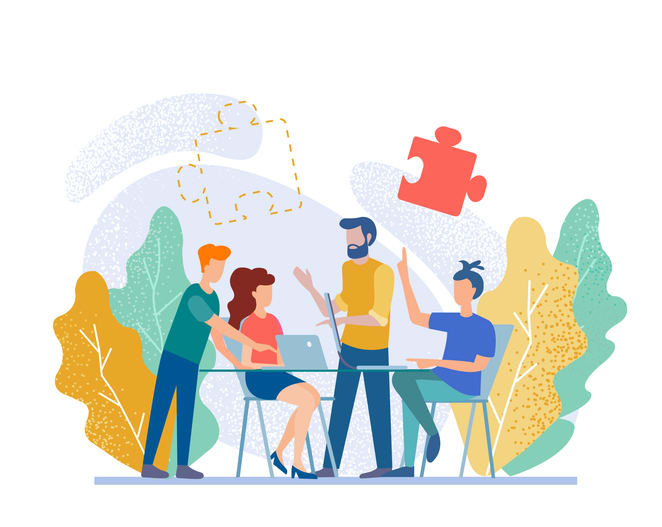Imagine a workplace where colleagues respect and support one another, open communication thrives, and everyone works together towards a common goal. Sounds like a dream, right? Now imagine that this dream can become a reality. In this blog post, we’ll help you unlock the power of positive workplace relationships by offering practical steps, insights from Kumospace, and advice on “how can you work on building positive relationships” to overcome obstacles that may stand in your way. Let’s start this journey towards stronger, more fulfilling professional connections!
Key takeaways
- Foster positive workplace relationships through open communication, employee engagement, and trust-building.
- Utilize emotional intelligence to manage stress and negative emotions while encouraging collaboration across departments.
- Proactively address negative relationships by aligning personal goals with organizational ones.
Unlocking the power of positive workplace relationships

Positive workplace relationships are the key to a thriving, happy, and productive work environment. A healthy relationship among colleagues can lead to good working relationships, increased job satisfaction, reduced turnover, and improved teamwork, making them essential for organizational success. Fostering positive relationships at work can also contribute to better mental health among employees.
Creating an atmosphere where positive relationships flourish involves focusing on open communication, employee engagement, and trust-building.
Understanding the value of solid relationships at work
Solid relationships at work can have a profound impact on the organization’s success. When employees feel connected and supported, they’re more likely to be engaged, innovative, and motivated to contribute their best efforts. Moreover, strong working relationships can also lead to increased job satisfaction and reduced turnover, as employees feel valued and committed to the organization’s mission.
Recognizing the value of solid relationships and prioritizing relationship-building efforts helps unlock the power of a good relationship, as well as fostering strong relationships.
The interplay between positive interactions and mental wellbeing
Did you know that positive interactions at work can directly influence mental wellbeing? Research shows that when workplace relationships are characterized by trust, cooperation, and fairness, the reward center of the brain is activated, leading to improved health and confidence. These positive interactions can also contribute to a healthier and more resilient workforce by strengthening the cardiovascular, immune, and neuroendocrine systems.
Fostering positive interactions benefits not only the building of strong working relationships but also the overall mental wellbeing of employees.
Crafting an atmosphere of open communication

Open communication is the foundation of positive workplace relationships. Encouraging an atmosphere where employees feel comfortable expressing their thoughts and feelings can lead to improved trust, cooperation, and understanding.
Creating a work environment where open communication thrives and relationships flourish involves fostering honest dialogue and utilizing technology to enhance connection.
Encouraging honest dialogue
Honest dialogue is crucial for developing trust, understanding, and collaboration among team members. By addressing issues head-on and engaging in candid conversations, employees demonstrate that they value and respect each other’s opinions, fostering a sense of trust and unity within the team.
Creating a safe space for employees to voice their concerns and opinions, promoting open discussions, and actively seeking feedback can encourage honest dialogue.
Utilizing technology for enhanced connection
Technology plays a significant role in promoting communication and connection in the workplace in the modern world. Platforms like Kumospace offer exceptional audio and video quality for clear communication, stimulating conversations, and fostering stronger relationships among team members.
From video conferencing to chat functionality and file sharing, technology can help bridge geographical gaps, streamline communication, and ultimately contribute to building positive workplace relationships.
Nurturing employee engagement through supportive actions

Nurturing engagement and fostering positive relationships involves supporting employees through recognition, celebration, and professional development opportunities. By demonstrating that you’re invested in their growth and acknowledging their hard work, you create a workplace where employees feel valued and motivated to contribute their best efforts.
Recognizing and celebrating hard work
Recognizing and celebrating hard work is a powerful way to boost morale and strengthen bonds between team members. By acknowledging employees’ contributions and efforts, you demonstrate appreciation, foster a sense of pride, and motivate them to continue working hard.
This can lead to a more cohesive and productive team, ultimately contributing to the success of the organization.
Providing resources for professional development
Demonstrating your commitment to employees’ growth and encouraging them to become better contributors to the organization involves investing in their professional development. By providing resources such as training programs, coaching, and mentoring, you can help employees develop new skills and improve their performance.
In turn, this can lead to stronger relationships and a more engaged workforce.
Building trust with consistency and reliability

Building trust, the cornerstone of any successful workplace relationship, requires consistency, reliability, and leading by example. By delivering on commitments and demonstrating that you can be counted on, you’ll inspire confidence and foster a positive work environment where employees feel supported and valued.
Delivering on commitments
Delivering on commitments is a powerful way to demonstrate reliability and trustworthiness. When employees see that their colleagues consistently fulfill their promises and responsibilities, they’re more likely to trust and rely on them. This sense of dependability can lead to stronger relationships and a more harmonious work environment.
Leading by example
Leading by example is an essential aspect of building trust in workplace relationships. By setting a positive tone and demonstrating the values and behaviors you expect from others, you inspire employees to follow suit and contribute to a positive workplace culture. This, in turn, fosters collaboration and strengthens relationships across the organization.
Fostering inclusivity and respect in team dynamics

Fostering positive team dynamics involves promoting inclusivity and respect. By embracing diversity and encouraging collaboration across departments, you create an inclusive environment where everyone’s perspectives are valued and appreciated. This, in turn, promotes positive interactions, teamwork, and a sense of unity within the organization.
Embracing diversity and avoiding power imbalances
Contributing to a more inclusive and harmonious work environment involves:
- Embracing diversity
- Avoiding power imbalances
- Actively promoting and valuing diverse perspectives
- Creating a sense of belonging and mutual respect among team members
- Fostering positive workplace relationships
- Encouraging collaboration and innovation
Encouraging collaboration across departments
Encouraging collaboration across departments not only breaks down silos within the organization but also promotes positive interactions among team members. By facilitating communication and cooperation between different departments, you create opportunities for employees to learn from each other, share ideas, and work together towards common goals.
Prioritizing personal connections amidst busy schedules

Prioritizing personal connections, such as interpersonal relationships, is necessary even amidst busy schedules and demanding workloads. Building and maintaining positive workplace relationships requires time and effort, but it’s well worth the investment.
By making time for social interactions and creating opportunities for team bonding, you can strengthen relationships and foster a supportive work environment.
Scheduling time for social interactions
Scheduling time for social interactions, such as coffee breaks or team lunches, is an effective way to strengthen bonds between team members. These informal gatherings provide a relaxed setting for employees to connect, share experiences, and build relationships.
By prioritizing social interactions, you create an atmosphere where employees feel comfortable and supported.
Creating opportunities for team bonding
Creating opportunities for team bonding is an excellent way to foster camaraderie and strengthen relationships among team members. Some examples of team bonding activities include:
- Team-building activities
- Offsite events
- Retreats
- Sports or recreational activities
- Volunteer work
These activities provide a chance for employees to interact outside of their usual work environment, allowing them to learn more about each other, develop trust, and work together more effectively.
Cultivating emotional intelligence for better interactions

Building positive relationships significantly involves cultivating emotional intelligence. By managing stress, focusing on empathy, and practicing active listening, you can create an environment where employees feel valued and understood.
Cultivating emotional intelligence not only enhances communication and collaboration but also contributes to a more positive and supportive workplace.
Managing stress and negative emotions
Maintaining a positive atmosphere and promoting healthy interactions among team members involves managing stress and negative emotions. By acknowledging and addressing stressors, employees can prevent them from negatively affecting relationships and work performance.
Developing strategies to manage stress and negative emotions can lead to a more focused and resilient workforce.
Focusing on empathy and active listening
Focusing on empathy and active listening allows for better understanding and connection, leading to stronger relationships. By putting oneself in another person’s shoes and truly listening to their concerns and perspectives, employees can foster a sense of trust and rapport. This, in turn, encourages open communication, collaboration, and a more positive work environment.
Overcoming obstacles to positive relationship building

Addressing negative relationships proactively and aligning personal and organizational goals are the key aspects in overcoming obstacles to positive relationship building. By tackling these challenges head-on and working together towards common objectives, employees can create a supportive and collaborative work environment where positive relationships thrive.
Addressing negative relationships proactively
Preventing further damage and promoting a positive work environment involves addressing negative relationships head-on and working to resolve issues. By acknowledging and addressing any issues that may arise, employees can foster open communication and mutual understanding, leading to improved relationships and a more harmonious workplace.
Aligning personal and organizational Goals
To foster collaboration and positive relationships by ensuring that everyone is working towards the same objectives, it’s important to align personal and organizational goals. By understanding and embracing the organization’s mission and values, employees can contribute to a unified and cohesive team, working together to achieve common goals and create a supportive work environment.
Summary
In conclusion, building positive workplace relationships is essential for creating a supportive, productive, and enjoyable work environment. By focusing on open communication, employee engagement, trust-building, inclusivity, and emotional intelligence, employees can forge strong connections and work together towards shared goals. Remember, investing in positive relationships is an investment in the success and well-being of your organization.
Frequently asked questions
To build positive relationships, aim to develop trust and mutual respect, practice mindful communication, welcome diversity, schedule time for relationship building, appreciate others and have a positive outlook.
Creating a positive working relationship is rooted in trust, respect, self-awareness, inclusion, open communication, diversity, mindfulness, and interrelatedness. By modeling, developing, and nurturing these attributes, teams can foster successful collaborations.
Good communication, honesty and professional behavior can help build trust and rapport. Listening actively is an important skill to develop, which will further help establish positive relationships.
Encourage honest dialogue, provide a safe space for employees to voice their concerns, and utilize technology to foster open communication in the workplace.
Acknowledging employees' contributions and efforts, holding awards ceremonies, and praising employees for their ideas and accomplishments are effective ways to recognize and celebrate hard work.





